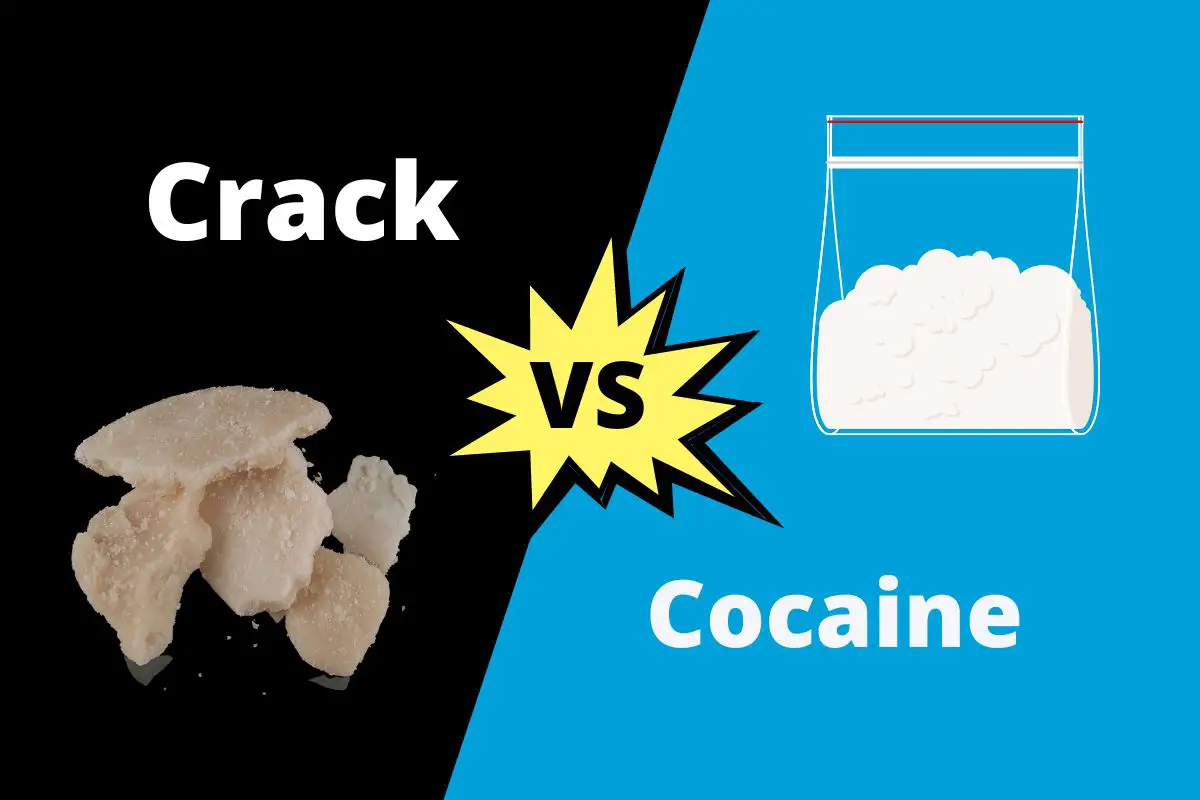The main difference between crack and cocaine is that crack has a solid rock-like form that can only be smoked. Cocaine, however, is a powder that can be snorted, injected, or swallowed.
There are a lot of stigmas attached to drugs in our society. Cocaine and crack are two highly addictive drugs you’ve probably seen in various news stories.
Disclaimer: The following information is intended for educational purposes only.
Table of Contents
Crack vs. Cocaine
| Crack | vs. | Cocaine |
| Smoked | How is it Taken? | Snorting, injecting and swallowing |
| Less expensive | Cost | More expensive |
| Wears off quickly | How Long Does the Effect Last? | Last for an hour |
| Solid rock form | Consistency | White powder form, similar to the regular baking soda |
What is Crack?
Crack (or crack cocaine) is the impure form of cocaine in solid rock crystal. The word “crack” is derived from the crackling sound generated while heating and smoking the drug.
It’s derived from powdered cocaine, which is a hydrochloride salt.
Crack Preparation
Powdered cocaine is first combined with water and other substances, primarily baking soda. This mixture is then boiled and solidified. Once cooled, the solids are broken into chunks and sold on the market.
Crack is very concentrated. Even a few grams of crack are highly addictive. It’s found in white, cream, tan, or light brown colors.
Long-Term Effects of Crack
Crack addiction has long-term effects and severe consequences on different organs.
- Lungs: Crack causes damage to respiratory organs and can worsen pre-existing respiratory problems like asthma. It can also cause pneumonia and interstitial lung disease.
- Heart: It also has severe and long-term effects on the heart, leading to heart attacks, high blood pressure, and high heart rate.
- Brain: Crack can damage the brain, leading to psychological issues like anxiety, psychosis, confusion, frequent mood changes, restlessness, and hallucinations. Moreover, it can physically damage the brain, resulting in difficulty learning, making decisions, or even memory loss.
Overdosing on crack can lead to coma and death.
What is Cocaine?
Cocaine is a white crystalline hydrochloride salt found in powdered form. Its chemical name and formula are benzoylmethylecgonine and C17H21NO4, respectively.
It’s obtained from the indigenous coca plant in South America and directly affects the central nervous system (CNS.)
Cocaine is a potent and highly addictive CNS stimulant that can impact your energy levels, attentiveness, and alertness.
This drug is often snorted, though it can also be swallowed or injected.
Cocaine is often identified as coke, snow, rock, and blow. Apart from the original form, it is also consumed after mixing with other severe drugs like opioids, which include heroin and fentanyl.
Cocaine’s effects on the body depend on how it’s administered. Its short-term impact includes decreased appetite, paranoia, irritation, and extreme sensitivity to sound, touch, and sight.
Cocaine for Medicinal Purposes
Cocaine, as a drug, is also used for medicinal purposes. For example, dentists and physicians use it to numb nasal tissues during surgery.
Long-Term Effects Of Cocaine
Snorting, injecting, or ingesting cocaine can cause long-term side effects and health problems such as:
- Bowel decay (if swallowed)
- Headaches
- Sexual issues
- Kidney damage
- Loss of smell, nosebleeds, runny nose, and trouble swallowing (if snorted)
- Convulsions and seizures
- Weakened immune system
- Heart diseases, such as heart attack and stroke
- Mood swings
- Lung damage
- HIV or hepatitis (if injected)
Overdosing on cocaine can lead to a higher death possibility, even if taken for the first time. Overdose symptoms include acute anxiety, confusion, nausea, heart attack, and stroke.
Crack vs. Cocaine – Key Differences
Crack and cocaine are derivatives yet have some significant differences. Here is a brief differentiation between the two.
Ingested
Cocaine is taken via snorting, injecting, and swallowing since it exists in powder form. In contrast, crack can only be smoked, being a rock.
Cost
Cocaine is more expensive than crack. It’s primarily due to the various administration methods of cocaine.
Length of Effects
If cocaine is taken via snorting, its effect lasts up to an hour. However, crack wears off quickly and thus is more addictive than cocaine.
Consistency
Cocaine is found in snowy white powder, while crack comes in a solid rock form. It can be whitish cream, tan, or light brown.
Comparing Crack and Cocaine
Cocaine and crack (or crack cocaine) are two chemically identical drugs. They are equally dangerous and have similar effects on the human body.
Both are equally dangerous. However, crack can be riskier than cocaine since it is smoked. It has quicker effects and increases the risk of addiction.
However, there are some key differences between these two drugs. The critical difference between these highly stimulant drugs is how they’re taken.
Getting Help for Drug Abuse
SAMHSA is the Substance Abuse & Mental Health Services Administration. SAMHSA is an agency within the U.S. Department of Health and Human Services that was created in 1992 to replace the alcohol, drug abuse, and mental health administration.
Reach out to the SAMHSA if you need support for drug abuse or mental health services.
If you’ve enjoyed this post, check out our post comparing blunt versus joint.


